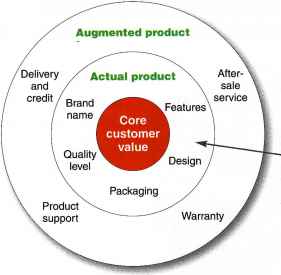Product and Service Classifications
Products and services fall into two broad classes based on the types of consumers that use them—consumer -products and industrial products. Broadly defined, products also include other marketable entities such as experiences, organizations, persons, places, and ideas.
Consumer Products
Consumer products are products and services bought by final consumers for personal consumption. Marketers usually classify these products and services further based on how consumers go about buying them. Consumer products include convenience products, shopping products, specialty products, and unsought products. These products differ in the ways consumers buy them and, therefore, in how they are marketed (see • Table 8.1).
Convenience products are consumer products and services that customers usually buy frequently, immediately, and with a minimum of comparison and buying effort. Examples include laundry detergent, candy, magazines, and fast food. Convenience products are usually low priced, and marketers place them in many locations to make them readily available when customers need them.
Shopping products are less frequently purchased consumer products and services that customers compare carefully on suitability, quality, price, and style. When buying shopping products and services, consumers spend much time and effort in gathering information and making comparisons. Examples include furniture, clothing, used cars, major appliances, and hotel and airline services. Shopping products marketers usually distribute their products through fewer outlets but provide deeper sales support to help customers in their comparison efforts.
Specialty products are consumer products and services with unique characteristics or brand identification for which a significant group of buyers is willing to make a special purchase effort. Examples include specific brands of cars, high-priced photographic equipment, designer clothes, and the services of medical or legal specialists. A Lamborghini automobile, for example, is a specialty product because buyers are usually willing to travel great distances to buy one. Buyers normally do not compare specialty products. They invest only the time needed to reach dealers carrying the wanted products.
Unsought products are consumer products that the consumer either does not know about or knows about but does not normally think of buying. Most major new innovations are unsought until the consumer becomes aware of them through advertising. Classic examples of known but unsought products and services are life insurance, preplanned funeral services, and blood donations to the Red Cross. By their very nature, unsought products require a lot of advertising, personal selling, and other marketing efforts.

Augmented product
Aftersale service
Delivery and credit /
Actual product
Brand name
Features
Quality level
Design
Packaging
Product support
Warranty
At the most basic level, the company asks, "What is the customer really buying?" For example, people who buy a BlackBerry are buying more than a wireless communications device. They are buying freedom and on-the-go connectivity. Each additional product level helps to build this core value.
• table i 8,1 Marketing Considerations for Consumer Products
Continue reading here: Individual Product and Service Decisions
Was this article helpful?
Readers' Questions
-
pansy5 months ago
- Reply
-
riitta1 year ago
- Reply
-
glen1 year ago
- Reply
-
alem1 year ago
- Reply
-
jukka-pekk1 year ago
- Reply
-
liliana1 year ago
- Reply
-
jole palermo1 year ago
- Reply
-
dennis1 year ago
- Reply
-
abraham1 year ago
- Reply
-
Mantissa1 year ago
- Reply
-
Nibs1 year ago
- Reply
-
Milla1 year ago
- Reply
-
steffen1 year ago
- Reply
-
Genet Abdullah1 year ago
- Reply
-
danyl1 year ago
- Reply